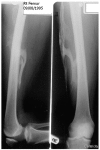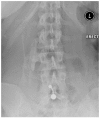A novel ACVR1 mutation in the glycine/serine-rich domain found in the most benign case of a fibrodysplasia ossificans progressiva variant reported to date
- PMID: 21044902
- PMCID: PMC3160462
- DOI: 10.1016/j.bone.2010.10.164
A novel ACVR1 mutation in the glycine/serine-rich domain found in the most benign case of a fibrodysplasia ossificans progressiva variant reported to date
Abstract
Fibrodysplasia Ossificans Progressiva (FOP) is a rare, autosomal dominant condition, classically characterised by heterotopic ossification beginning in childhood and congenital great toe malformations; occurring in response to a c.617 G > A ACVR1 mutation in the functionally important glycine/serine-rich domain of exon 6. Here we describe a novel c.587 T > C mutation in the glycine/serine-rich domain of ACVR1, associated with delayed onset of heterotopic ossification and an exceptionally mild clinical course. Absence of great toe malformations, the presence of early ossification of the cervical spine facets joints, plus mild bilateral camptodactyly of the 5th fingers, together with a novel ACVR1 mutation, are consistent with the 'FOP-variant' syndrome. The c.587 T > C mutation replaces a conserved leucine with proline at residue 196. Modelling of the mutant protein reveals a steric clash with the kinase domain that will weaken interactions with FKBP12 and induce exposure of the glycine/serine-rich repeat. The mutant receptor is predicted to be hypersensitive to ligand stimulation rather than being constitutively active, consistent with the mild clinical phenotype. This case extends our understanding of the 'FOP-variant' syndrome.
Crown Copyright © 2010. Published by Elsevier Inc. All rights reserved.
Figures




Similar articles
-
Classic and atypical fibrodysplasia ossificans progressiva (FOP) phenotypes are caused by mutations in the bone morphogenetic protein (BMP) type I receptor ACVR1.Hum Mutat. 2009 Mar;30(3):379-90. doi: 10.1002/humu.20868. Hum Mutat. 2009. PMID: 19085907 Free PMC article.
-
ACVR1 (587T>C) mutation in a variant form of fibrodysplasia ossificans progressiva: second report.Am J Med Genet A. 2014 Jan;164A(1):220-4. doi: 10.1002/ajmg.a.36219. Epub 2013 Nov 20. Am J Med Genet A. 2014. PMID: 24259422 Review.
-
Mutational analysis of the ACVR1 gene in Italian patients affected with fibrodysplasia ossificans progressiva: confirmations and advancements.Eur J Hum Genet. 2009 Mar;17(3):311-8. doi: 10.1038/ejhg.2008.178. Epub 2008 Oct 1. Eur J Hum Genet. 2009. PMID: 18830232 Free PMC article.
-
Rarely occurring mutation of ACVR1 gene in Moroccan patient with fibrodysplasia ossificans progressiva.Clin Rheumatol. 2010 Jan;29(1):119-21. doi: 10.1007/s10067-009-1283-z. Epub 2009 Oct 1. Clin Rheumatol. 2010. PMID: 19795179
-
BMP signaling and skeletal development in fibrodysplasia ossificans progressiva (FOP).Dev Dyn. 2022 Jan;251(1):164-177. doi: 10.1002/dvdy.387. Epub 2021 Jun 26. Dev Dyn. 2022. PMID: 34133058 Free PMC article. Review.
Cited by
-
TGF-β and BMP signaling in osteoblast, skeletal development, and bone formation, homeostasis and disease.Bone Res. 2016 Apr 26;4:16009. doi: 10.1038/boneres.2016.9. eCollection 2016. Bone Res. 2016. PMID: 27563484 Free PMC article. Review.
-
Protocol paper: a multi-center, double-blinded, randomized, 6-month, placebo-controlled study followed by 12-month open label extension to evaluate the safety and efficacy of Saracatinib in Fibrodysplasia Ossificans Progressiva (STOPFOP).BMC Musculoskelet Disord. 2022 Jun 1;23(1):519. doi: 10.1186/s12891-022-05471-x. BMC Musculoskelet Disord. 2022. PMID: 35650602 Free PMC article.
-
Phenotypic differences of patients with fibrodysplasia ossificans progressive due to p.Arg258Ser variants of ACVR1.Hum Genome Var. 2015 Dec 10;2:15055. doi: 10.1038/hgv.2015.55. eCollection 2015. Hum Genome Var. 2015. PMID: 27081558 Free PMC article.
-
Understanding Tendons: Lessons from Transgenic Mouse Models.Stem Cells Dev. 2018 Sep 1;27(17):1161-1174. doi: 10.1089/scd.2018.0121. Epub 2018 Aug 10. Stem Cells Dev. 2018. PMID: 29978741 Free PMC article.
-
Accumulated Knowledge of Activin Receptor-Like Kinase 2 (ALK2)/Activin A Receptor, Type 1 (ACVR1) as a Target for Human Disorders.Biomedicines. 2021 Jun 26;9(7):736. doi: 10.3390/biomedicines9070736. Biomedicines. 2021. PMID: 34206903 Free PMC article. Review.
References
-
- Shore EM, Xu M, Feldman GJ, Fenstermacher DA, Cho TJ, Choi IH, et al. A recurrent mutation in the BMP type I receptor ACVR1 causes inherited and sporadic fibrodysplasia ossificans progressiva. Nat Genet. 2006;38:525–7. - PubMed
-
- Connor JM, Evans DA. Fibrodysplasia ossificans progressiva. The clinical features and natural history of 34 patients. J Bone Joint Surg Br. 1982;64:76–83. - PubMed
-
- Lin GT, Chang HW, Liu CS, Huang PJ, Wang HC, Cheng YM. De novo 617 G-A nucleotide mutation in the ACVR1 gene in a Taiwanese patient with fibrodysplasia ossificans progressiva. J Hum Genet. 2006;51:1083–6. - PubMed
-
- Nakajima M, Haga N, Takikawa K, Manabe N, Nishimura G, Ikegawa S. The ACVR1 617 G>A mutation is also recurrent in three Japanese patients with fibrodysplasia ossificans progressiva. J Hum Genet. 2007;52:473–5. - PubMed
Publication types
MeSH terms
Substances
Grants and funding
LinkOut - more resources
Full Text Sources
Other Literature Sources

